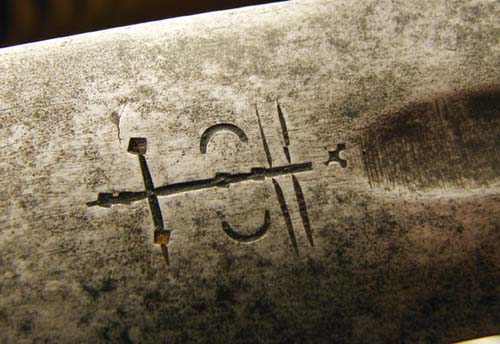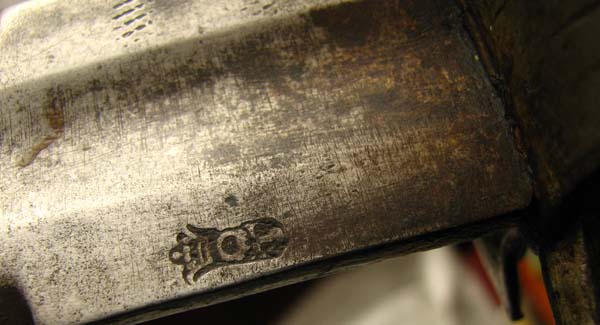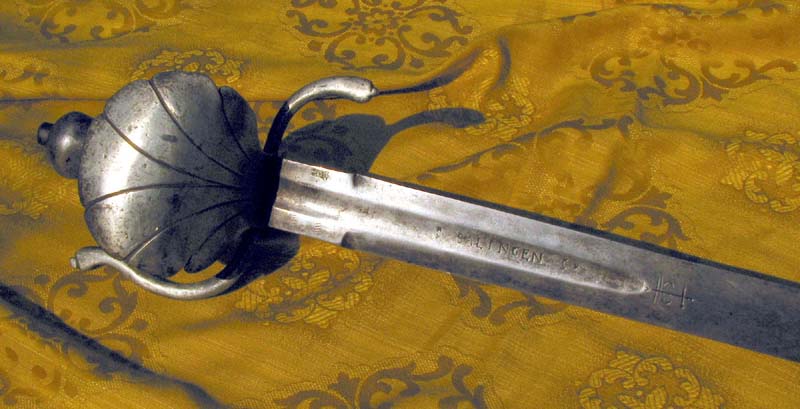| Author |
Message |
|
Lucas S
Location: poland Joined: 25 Dec 2007
Posts: 23
|
 Posted: Mon 05 Apr, 2010 1:04 am Post subject: help in identification XVIIc. sword Posted: Mon 05 Apr, 2010 1:04 am Post subject: help in identification XVIIc. sword |
 |
|
hi, could somebody tell me something more about this sword ? for me it's any XVII century german sword. it's all i know.
what kind of infantry was use this sword? what time was this sword probably made?
there is inscribed "salingen me fecit".. but what do mean other symbols? i heard that this sign O on T under the crown is spanish mark... but here is connected with inscription "salingen..."
thanx for any help
 Attachment: 49.72 KB Attachment: 49.72 KB

 Attachment: 45.37 KB Attachment: 45.37 KB

 Attachment: 64.08 KB Attachment: 64.08 KB

 Attachment: 37.47 KB Attachment: 37.47 KB

|
|
 |
 |
|
Peter Johnsson
Industry Professional
|
 Posted: Mon 05 Apr, 2010 1:26 am Post subject: Posted: Mon 05 Apr, 2010 1:26 am Post subject: |
 |
|
I am afraid I cannot add much detail in identifying this sword. Just wanted to add that this can well be an example of a spanish made "german" sword, just as "spanish" swords were forged in germany.
Anything that makes the customer more happy about the quality of his blade was good business...
|
|
   |
 |
Gabriele C.

Location: Roma,Italia Joined: 09 Apr 2007
Posts: 38
|
 Posted: Mon 05 Apr, 2010 1:57 am Post subject: Posted: Mon 05 Apr, 2010 1:57 am Post subject: |
 |
|
It's a mark from a Toledo swordmaker (crown-O-T). On the other side, "Solingen" reminds me an important armourers centre (High Rhine) from XII to XIX century. Solingen reached his zenit in the late XVI century, with Clement Horn and Jan Hopp.Until French domination, Solingen armourers had a great control over the other armorers of the High Rhine. All of them had to bring their weapons to Solingen to obtain a test-mark, a real certification of weapon quality, from the Chief of Solingen Armourers. Maybe the mark on your sword it's a test-mark impressed on a blade brought from Spain?
my blog
http://zweilawyer.wordpress.com/
|
|
  |
 |
|
Lucas S
Location: poland Joined: 25 Dec 2007
Posts: 23
|
 Posted: Mon 05 Apr, 2010 3:42 am Post subject: Posted: Mon 05 Apr, 2010 3:42 am Post subject: |
 |
|
thanks,
ok. then crown-O-T is spanish mark, but inscription tell us that solingen made it. it does not seems like test mark... what means this spanish mark? it's any sword maker sign or maybe just an armoury mark? what is the cross sign punched in the end of the fuller? is it connected with crown-o-t or it's another one, separated, symbol?
maybe blade was forged in spain(and punched in spanish marks) and polished in solingen for german soldier? maybe sign "salingen..." is added later, after hilt was attached? (i bought it in germany)
was there any spanish swordsmith working in solingen??
where and when this kind of sword was using? germany or spain?
|
|
 |
 |
|
JG Elmslie
Industry Professional
|
 Posted: Mon 05 Apr, 2010 6:01 am Post subject: Posted: Mon 05 Apr, 2010 6:01 am Post subject: |
 |
|
possibiilty its german, made to look like a spanish maker, perhaps?
was'nt unheard of, there's the stunning gold encrusted hollow-pommeled rapier in the Glasgow Museums collection which is marked with toledo marks, but almost certainly a german blade with fake marks, for example.
just a thought... 
|
|
   |
 |
Arek Przybylok

Location: Upper Silesia Joined: 16 Jan 2007
Posts: 112
|
 Posted: Mon 05 Apr, 2010 6:39 am Post subject: Posted: Mon 05 Apr, 2010 6:39 am Post subject: |
 |
|
|
Question on the margin of the major problem. Do you know the length and the weight perhaps?
|
|
   |
 |
|
Lucas S
Location: poland Joined: 25 Dec 2007
Posts: 23
|
 Posted: Mon 05 Apr, 2010 7:24 am Post subject: Posted: Mon 05 Apr, 2010 7:24 am Post subject: |
 |
|
i have no good scale but weight is something about 1,2kg(hilt is very heavy)
lenght of the sword is 91cm... the blade is 76,5cm. point of balance - 10,5cm form the crossguard.
for more information mail to: lukpuh@interia.pl
|
|
 |
 |
|
Lucas S
Location: poland Joined: 25 Dec 2007
Posts: 23
|
 Posted: Tue 06 Apr, 2010 8:15 am Post subject: Posted: Tue 06 Apr, 2010 8:15 am Post subject: |
 |
|
i've just found the small piece of information.
there is the passau wolf(from solingen) connected with the crown-o-t symbol in the post number 39, fig. 12. picture is taken from the book: Rudolf Cronau's - Geschichte der Solinger Klingenindustrie 1885
http://www.vikingsword.com/vb/showthread.php?p=55264
about toledo marks i've found: http://chestofbooks.com/home-improvement/furn...art-3.html
1. there are signs with the O - T letters, but all of them are without crown. crown is above othe letters like F, G, etc.
2. actually there is no O-T mark between spanish symbols. it's rather point above T. it's just similar to O-T
does anyone have Rudolf Cronau's book? ...or Richard Bezdek's "German swords and sword makers..."?
|
|
 |
 |
|
|

